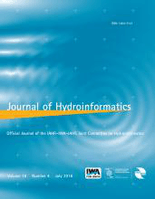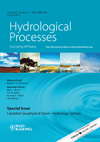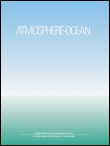
JOURNAL OF HYDROMETEOROLOGY
Scope & Guideline
Elevating Knowledge in Weather and Climate Studies
Introduction
Aims and Scopes
- Precipitation Measurement and Estimation:
Research in this area involves innovative techniques for measuring precipitation, including satellite observations, radar systems, and ground-based sensors. The goal is to improve accuracy in precipitation estimation and its implications for hydrological studies. - Hydrological Modeling and Forecasting:
This scope covers the development and evaluation of models that simulate hydrological processes, including rainfall-runoff modeling and flood forecasting. It incorporates various methodologies, including machine learning and data assimilation, to enhance predictive capabilities. - Impact of Climate Change on Water Resources:
Studies focus on understanding how climate change affects precipitation patterns, drought occurrences, and water availability. Research in this area aims to provide insights into adaptive management strategies for water resources under changing climate conditions. - Land-Atmosphere Interactions:
This area investigates the feedback mechanisms between land surface conditions and atmospheric processes, including how land use and vegetation affect precipitation and evaporation rates. - Extreme Weather Events and Their Hydrological Impacts:
This scope emphasizes research on the hydrological consequences of extreme weather events such as heavy rainfall, droughts, and floods, and aims to improve understanding and prediction of such events.
Trending and Emerging
- Integration of Machine Learning in Hydrometeorology:
There is a growing trend in applying machine learning techniques to improve precipitation forecasts, hydrological modeling, and data assimilation processes. This approach enhances the ability to analyze large datasets and extract meaningful patterns. - Satellite and Remote Sensing Technologies:
The use of satellite data for precipitation estimation and hydrological monitoring is gaining prominence. Research is increasingly focused on developing new algorithms and validation techniques to enhance the accuracy of satellite-derived precipitation products. - Flash Flood and Drought Prediction:
Studies focusing on flash floods and droughts are emerging as critical areas of research, particularly in the context of climate variability. This includes modeling and prediction efforts that integrate atmospheric and hydrological data to anticipate extreme events. - Water Resource Management in a Changing Climate:
Research is increasingly addressing the implications of climate change on water resource management strategies, emphasizing sustainable practices and adaptation measures to mitigate adverse impacts on water availability. - Hydrological Impacts of Urbanization:
There is an emerging focus on understanding how urbanization affects local hydrology, including changes in precipitation patterns, runoff, and flood risks. This research is crucial for developing urban planning and management strategies that account for hydrometeorological impacts.
Declining or Waning
- Traditional Hydrological Data Collection Methods:
There has been a noticeable shift away from conventional methods of data collection, such as manual rain gauge measurements, in favor of remote sensing and advanced modeling techniques. This trend reflects a growing reliance on technology for data accuracy and coverage. - Static Climate Models for Precipitation Forecasting:
Research utilizing static or less adaptive climate models for precipitation forecasting is declining. There is a trend towards more dynamic models that incorporate real-time data and machine learning techniques for enhanced accuracy. - Focus on Localized Hydrological Studies:
There is a diminishing emphasis on localized hydrological studies that do not consider broader regional or global contexts. The current trend favors research that integrates multiple scales and datasets to address complex hydrometeorological challenges.
Similar Journals

JOURNAL OF GEOPHYSICAL RESEARCH-ATMOSPHERES
Exploring the dynamics of our planet's atmosphere.JOURNAL OF GEOPHYSICAL RESEARCH-ATMOSPHERES, published by the American Geophysical Union, is a leading peer-reviewed journal dedicated to advancing our understanding of atmospheric science and related disciplines. With an impressive impact factor and consistently holding a Q1 ranking across key categories including Atmospheric Science and Geophysics, this esteemed journal caters to a global audience of researchers, professionals, and students eager to explore groundbreaking studies and insights. The journal covers a comprehensive scope of topics, from climate dynamics to atmospheric processes, enhancing knowledge and informing practices within the realm of Earth and Planetary Sciences. With its strong emphasis on quality research, it remains a vital resource for those engaged in unraveling the complexities of our planet’s atmosphere. Explore this journal to stay abreast of significant developments and foster a deeper understanding in this ever-evolving field.

Idojaras
Exploring the intricacies of climate and weather phenomena.Idojaras, a prominent journal published by the Hungarian Meteorological Service, has been a vital contributor to the field of Atmospheric Science since its inception in 1980. With a specific focus on the intricacies of weather phenomena, climate variability, and environmental change, this journal serves as a platform for researchers and professionals to disseminate their findings. Although currently categorized in Q4 of Atmospheric Science with a Scopus rank of #122 out of 148, Idojaras is dedicated to improving its impact and visibility through rigorous peer-reviewed research and comprehensive analyses that engage a global audience. This scholarly publication, which operates without open access, is pivotal for advancing knowledge in meteorological studies, thereby appealing not only to seasoned scientists but also to students and scholars eager to explore this dynamic field. Located in Budapest, Hungary, the journal continues to strive for excellence in its coverage through the convergence of past and present meteorological research, making it a significant resource for anyone interested in the atmospheric sciences.

JOURNAL OF HYDROINFORMATICS
Connecting Disciplines to Transform Water Science.JOURNAL OF HYDROINFORMATICS, published by IWA PUBLISHING in the United Kingdom, is a leading open access journal in the field of water-related sciences and engineering. Since its inception in 1999, it has evolved to become a pivotal platform for the dissemination of significant research and innovative findings, especially after adopting an open access model in 2021. The journal spans a broad scope, intersecting various disciplines such as atmospheric science, civil and structural engineering, geotechnical engineering, and water science and technology, with its 2023 rankings placing it impressively in the Q2 quartile across several categories. With an impact factor reflective of its esteemed position within the academic community and its reach underscored by its Scopus rankings, the JOURNAL OF HYDROINFORMATICS appeals to a diverse readership including researchers, professionals, and students dedicated to advancing knowledge in hydroinformatics and related fields. Whether you are seeking to publish your cutting-edge research or to stay informed on the latest developments, this journal serves as an indispensable resource.

JOURNAL OF THE AMERICAN WATER RESOURCES ASSOCIATION
Empowering professionals with essential knowledge in water science.The JOURNAL OF THE AMERICAN WATER RESOURCES ASSOCIATION, published by Wiley, is a premier platform dedicated to advancing the field of water resource management and research. With an ISSN of 1093-474X and an impressive Q1 ranking in multiple categories, including Earth-Surface Processes, Ecology, and Water Science and Technology, this journal serves as a vital resource for professionals, researchers, and students alike. Established in 1967 and set to converge through 2024, it has consistently published cutting-edge research that influences policy and practice in water resource management. The journal's open access option enhances its reach, ensuring that critical findings are accessible to a wider audience. The Scopus rankings further underscore its impact, placing it in the top quartile within its fields, highlighting its importance in shaping scholarly discourse. As a significant contributor to the understanding and management of freshwater systems, the journal offers a crucial means for sharing insights and fostering collaboration in the vital realm of water resources.

ADVANCES IN ATMOSPHERIC SCIENCES
Advancing Knowledge for a Sustainable EnvironmentADVANCES IN ATMOSPHERIC SCIENCES is a highly esteemed journal published by SCIENCE PRESS, dedicated to advancing the field of atmospheric sciences. With an impressive impact factor and ranking as Q1 in Atmospheric Science as of 2023, this journal serves as a leading platform for researchers, professionals, and students to disseminate substantial findings and innovative methodologies across various topics within the atmospheric sciences domain. Established in 1984 and continuously publishing through to 2024, it has successfully positioned itself among the top ranks, currently standing at #17 out of 148 in the Scopus category, highlighting its significance in the field with a remarkable 88th percentile. Although it operates under traditional access, the journal provides invaluable insights into climate dynamics, meteorology, and environmental processes that are crucial for both academic and practical applications. Based in Beijing, China, ADVANCES IN ATMOSPHERIC SCIENCES is committed to fostering a global dialogue and collaboration among scholars and industry experts, making it an essential resource for those invested in understanding and addressing contemporary atmospheric challenges.

Water
Championing high-quality research for a water-secure world.Water, an esteemed journal published by MDPI, serves as a pivotal resource for global research in the fields of aquatic science, biochemistry, geography, and water science and technology. Since its inception in 2009, this open-access journal has committed itself to advancing knowledge regarding water-related topics by fostering a platform that encourages the dissemination of high-quality research. With its impressive impact factor reflecting its relevance and influence, Water ranks in the top quartiles in various categories, including Q1 in Aquatic Science and Water Science and Technology, showcasing its commitment to publishing cutting-edge findings that resonate deeply with the environmental and biological sciences community. Located in Basel, Switzerland, the journal prioritizes accessibility for researchers, professionals, and students alike, aligning with the broader scientific goal of addressing urgent water challenges through collaborative and interdisciplinary research.

LHB-Hydroscience Journal
Championing Open Access to Transform Water ManagementLHB-Hydroscience Journal, published by Routledge Journals, Taylor & Francis Ltd in the United Kingdom, stands as a significant platform in the realm of Water Science and Technology. Since its inception in 2021, this open-access journal has been dedicated to disseminating high-quality research that addresses the critical challenges faced in hydroscience, aiming particularly at fostering innovative solutions for sustainable water management. With an impressive E-ISSN of 2767-8490, it offers researchers, professionals, and students the opportunity to access cutting-edge findings without any paywall, thereby promoting wider dissemination and engagement within the academic community. Although it currently holds a Q4 quartile ranking and ranks #208 out of 261 in the Environmental Science category, the journal aspires to elevate its scholarly impact through rigorous peer-reviewed articles that contribute to the field from 2021 to 2024. As recognition of its growing significance, LHB-Hydroscience Journal invites contributions that explore the multidimensional aspects of water science—from interdisciplinary methodologies to real-world applications—catering to an audience eager to push the boundaries of current knowledge.

HYDROLOGICAL PROCESSES
Pioneering Research in Water ScienceHYDROLOGICAL PROCESSES, published by WILEY, stands as a leading journal in the realm of Water Science and Technology. With an impressive impact factor and a prestigious ranking of Q1 in its category, the journal has carved a niche for itself since its inception in 1986, continuing to disseminate insightful research through to 2024. It boasts a solid Scopus ranking, sitting at #59 out of 261 in the Environmental Science field, placing it in the 77th percentile and emphasizing its relevance in the study of hydrological dynamics. Although not an open access journal, it provides essential and impactful articles that contribute to understanding hydrological phenomena, ensuring broad accessibility through libraries and institutional subscriptions. Researchers, professionals, and students alike will find HYDROLOGICAL PROCESSES a vital resource for the latest studies and advancements in water resource management and environmental sustainability.

Hydrology
Advancing water science for a sustainable future.Hydrology, published by MDPI, is a prominent open-access journal dedicated to advancing the field of hydrological science. Since its establishment in 2014, the journal has garnered a reputation for excellence, reflected in its classification within the Q2 quartile for 2023 across multiple categories including Earth-Surface Processes, Oceanography, Water Science and Technology, and Waste Management and Disposal. Based in Switzerland, Hydrology provides a vital platform for scholars and practitioners to disseminate research findings, promote innovative methodologies, and foster discussions on current trends affecting water resources and management globally. The journal is easily accessible online and aims to significantly contribute to the understanding of hydrological processes, offering insights that are pivotal for addressing contemporary environmental challenges. With Scopus rankings showcasing its growing influence, Hydrology is a crucial resource for researchers, students, and professionals committed to water science and sustainable practices.

ATMOSPHERE-OCEAN
Advancing Knowledge in Atmospheric and Oceanic InteractionsATMOSPHERE-OCEAN is a premier peer-reviewed journal published by Taylor & Francis Ltd, dedicated to advancing the fields of atmospheric science and oceanography. Since its inception in 1963, this journal has served as a crucial platform for researchers, professionals, and students, facilitating the dissemination of significant findings and innovative methodologies in understanding the complex interactions between the atmosphere and the ocean. With its journal ranking in the Q3 category for Atmospheric Science and Q2 for Oceanography as of 2023, along with its Scopus rankings, ATMOSPHERE-OCEAN maintains its relevance by addressing current topics such as climate change, hydrology, and ocean circulation patterns. For those seeking to contribute to or stay informed about the latest research in these critical fields, ATMOSPHERE-OCEAN is an invaluable resource that combines rigorous scholarship with practical implications for environmental management and policy.